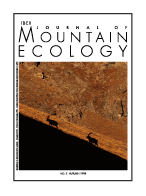|
SURVIVORSHIP
AMONG YOUNG ALPINE MARMOTS AND THEIR PERMANENCE IN THEIR NATAL
TERRITORY IN A HIGH ALTITUD COLONY.
Daniela Lenti Boero
Abstract - During an eight year study on the ethology
and ecology of the alpine marmot (Marmota marmota L.), carried out in
the Gran Paradiso National Park, Aosta, Italy, 41 young marmots were
individually recognized and data on birth rate, litter size, permanence
beyond maturity, and productivity were recorded. Litter size had a
median of four (range 4-5). No female had a litter in the first year of
settling and all females but one had a one year interval in
reproduction. 36.6%; 34.1%; 21.5% and 0 animals born in the colony were
found in the natal territory when one, two, three and four years old,
respectively. The differences found in comparison to other geographical
areas might be related to the high turnover rate of social groups and
indirectly to the harshness of the habitat where the study area is
located.
|


